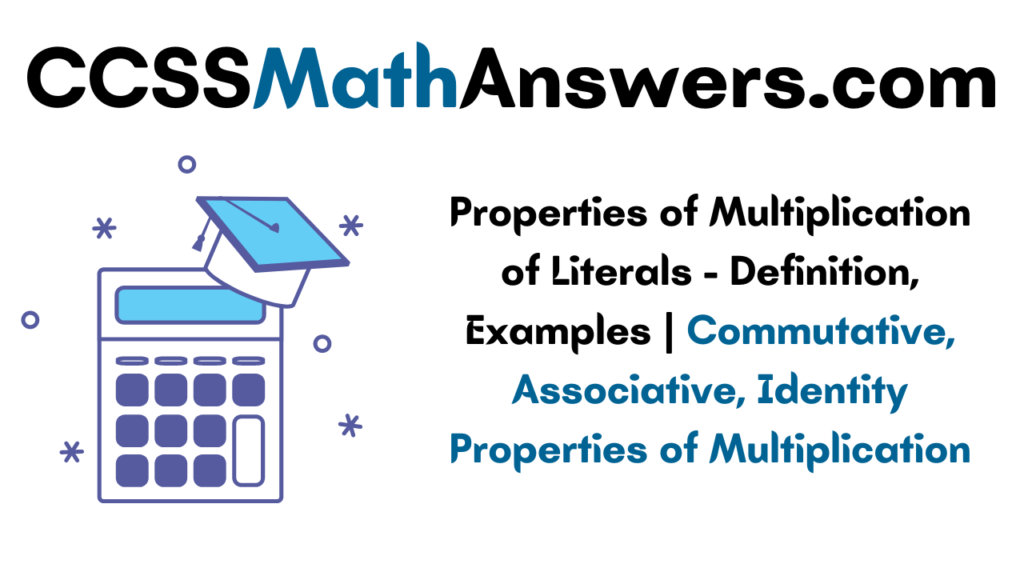Introduction: Basically, to perform the Literals multiplication there are certain properties. Based on properties multiplication properties such as Associative, Commutative, and Identity the product operation is done. Through this article, the students of 6th Grade Math were beneficial in getting the Literal Multiplication in a simple and fast procedure. Hence, go through the below article to know about the Properties of Multiplication of Literals with a few Examples.
Various Multiplication Properties of Literals
In this section let us see the various Multiplication of Properties as shown below with a little bit of brief Explanation of every Property.
1). Associative Property: Basically, the name of the Property Associate itself indicates that it is relating to something. As per this property, the product of three or several Literal persists in a similar value. It elucidates the manner that the grouping of numbers in a given question cannot alter the product of Numbers. The numbers which are grouped inside the parenthesis, are taken as a single section.
(r x s) x t = r x (s x t )
By grouping the Numbers through the assistance of Braces we can perform the Multiplication operation in a simple way.
2). Commutative Property: The Word commutative arrives from the word which is known as “commute”. It is specified with the formula as shown below.
r x s = s x r
3). Identity Property: Suppose there is a Literal r, it is stated with the Formula as shown below.
r x 1 = 1 x r
Also, See:
Multiplication Properties of Literals Examples
Question: 1
Which property is used for the Expression 3 x 5 = 5 x 3?
Solution:
Given 3 and 5 are two Literal Numbers. It seems to be like commutative Property so, Let us utilize and Verify by using the Commutative Property as Shown below.
r x s = s x r
Let r = 3 and s = 5 . Then Both the values in the formula give the result as 15. It means Both L.H.S and R.H.S are Equal.
Hence the Result obtained after multiplying 3 x 5 = 5 x 3 = 15.
Question: 2
What is the result obtained when the given Expression is (9 x 7) x 6 = 9 x (7 x 6)?
Solution:
Given 9,7 and 6 are three Literals. It appears as an Associative Property. Hence by employing this property we will solve the Given Expression as below.
(r x s) x t = r x (s x t ).
Let r= 9, s=7 and t=6
(9 x 7) x 6 = 9 x (7 x 6)
63 x 6 = 9 x 63
63 x 6 =378
378 = 378
By substituting the values in the formula the result obtained is 378
Question: 3
What is the value of 6 x 1 = 1 x 6?
Solution:
It seems to be an Identity Property i.e. r x 1 = 1 x r .Substitute it in the identity Property formula as shown below.
6 x 1 = 1 x 6
6 = 6
FAQ’s on Multiplication of Literals Properties
1). How many kinds of properties are Exist for performing the Literal Multiplication?
There are three kinds of properties like Commutative, Associative, and Identity.
2). Does the Commutative, Associative, and Identity properties are applicable for subtraction and Division of Literals?
No, the Commutative, Associative, and Identity properties are applicable for only Addition and Multiplication.
3). Does the expression 15 x 4 = 4 x13 state the commutative property of multiplication?
No, it is not a Commutative property, because the Commutative Property is r x s = s x r. According to the Given Data 15 x 4 = 4 x 13
60 = 52
4). What is the answer for the given Expression 5x (6×3) = (5x……)x3?
According to the Associative Property (r x s) x t = r x (s x t ) So, 5x (6×3) = (5×6) x3? the answer in the blank is 6.
